Battle Passes are looking like an established trend in free-to-play games, especially PVP, slowly substituting the older aspirations of subscription models that have only been successful for a handful of titles. What exactly is a battle pass, how can it influence your game’s economy, and how do you balance one?
Battle pass mechanics
As stated above a battle pass functions similarly to a subscription. Players can purchase battle passes either with real money or with in-game hard currency, and in return receive a set of rewards. But what does it make them different from classic in-app purchases then? First off, a battle pass does not give the player rewards off the bat. Rewards are earned through a level-up system (also called tiers) where each level (or a bunch of levels) unlocks a reward for the player.
The next question then becomes how does the player level up? Well here comes the interesting part: they do so by playing the game. Battle passes have their own experience pool and some games opt to give players experience in a simple way, such as winning a game or playing 5 games in a day. But a lot of games give battle pass experience through quests. Those quests can be as simple as “win a game as an assassin” or as complex as “get 10 kills with x weapon while on the defending side”. What does that mean? This system is great for two reasons:
1. Players that are already playing the game can get rewards for lower prices.
The idea of a battle pass is that you can get rewards by spending less money compared to in-app purchases. The trade-off is that you, as a player, have to play the game constantly in order to get those rewards. But that downside is not so much a downside when you are playing the game regardless. Take for example a game like League of Legends. For someone that plays it daily, throwing in some riot points for extra rewards that you would normally get for 5 times the amount of those points seems like a pretty good deal.
2. Quests incentivise players to try out different gameplay styles.
This is important especially for new players. It’s easy to find a favourite hero or favourite weapon in a free-to-play game and spam that same gameplay style to no end, but that ends up making the game boring as a result. By encouraging players to try out different things, you help out new players learn the game on a broader level, while also reducing the boredom factor for older players. Having committed to a battle pass, even if the players do not agree to some missions, they will still try and complete them for the rewards. And let’s face it, each of us at some point did one thing that we thought we wouldn’t like, but ended up enjoying it.
We can draw a conclusion from this. The battle pass is a cheaper method of getting in-game rewards but requires time investment from the player. This raises several questions regarding battle pass balancing. If done wrong, it can ruin your whole game economy, but if done right, it can be your next big moneymaker.
Balancing a Battle Pass
There are several factors to be considered when implementing a Battle Pass. We will discuss each of them in order.
1. Duration
There is no single rule that dictates how long a battle pass should last. Most of them opt for a duration between one or two months (Genshin Impact for instance has a 40-days battle pass), while some extreme cases opt for longer cycles (like Dota 2’s battle pass that can go up to half a year).
As battle passes do have a cycling system (when one ends, a new one begins, even if not immediately), it is important to determine how long you want your own battle pass’s cycle to be. A lower duration increases the chance of individual purchases, as players can have a month where they are more active in-game and choose that month as a good time for a battle pass, while a longer period can give you better prices and better retention for those players that do opt to make the commitment.
2. Rewards
Rewards are a very important aspect to consider. They have to be just right so that non-spending players find enough value to finally cave in, while already spending players do not get everything that they previously got from in-app purchases from the pass, thus eliminating the need for their regular purchases.
Such a case occurred with Supercell’s Clash Royale where the battle pass rewards combined with a lack of healthy in-game progression caused the already spending players to rely on the battle pass for their rewards. That meant that even though the pass brought new spending players, the already spending ones started to spend way less, thus resulting in a massive decrease in revenue. For that reason, it is also very important to figure out exactly how a battle pass will impact your own game’s already existing economy.
The frequency that these rewards are given is also a point of discussion. This is a combination of duration and rewards. This is usually dealt with by adding a daily/weekly experience cap on your battle pass. You don’t want a player going at the game for 50 hours straight and unlocking all rewards, you want a player that logs in daily or at least every other day. You don’t want to make that cap too rough either, the last thing you want is preventing a player from playing your game.
3. Quests
You’ve opted for a quest approach for your game’s battle pass progression, good for
you. But now you have to make sure that those quests can actually be fun, or at least encourage the players to expand their horizons. As a battle pass is repetitive by nature (due to its cyclical nature) it is impossible to come up with exciting new quests every time, that is why quests will most likely end up being repetitive and grindy.
Nobody is expecting those quests to be top-notch, but they at least shouldn’t make the player regret that he chose to complete them (Making players collect 200 flowers on some distant field might make them realise that keeping the money for themselves and just playing the game normally might be a better deal). As said at the beginning of the article, quests should incentivise the player to discover everything the game has to offer, while not feeling like a chore.
4. Price
This is more or less a combination of all the above factors but it goes without saying that determining the right price for your battle pass goes a long way. Make it too profitable for the player and it might destroy your existing economy, make it too expensive and no one will touch it. The key is making the player get good rewards for less money while also helping with the retention of these players. If handled properly it can be a win-win situation.
Using Machinations to balance a Battle Pass
Now that we know that balancing a battle pass is no easy task it’s time to look at how one can tackle it. I used Machinations to do that and built a very basic, generic battle pass model.
Hit Play in the embedded diagram above to follow along, and let’s talk about the model’s specifics first:
- We have 3 different daily quests, each with its own reward and chance of being completed
- It takes 100 points for one battle pass level, and the maximum level is capped at 25
- Every 5th level of the battle pass gives a reward which is worth 3 dollars in in-app purchases value, the rest of the levels give one dollar worth of rewards
- The battle pass lasts for 40 days, regardless if the player hits the level cap or not
So what are the balancing points here? Well, the short and boring answer would be everything, but let’s get into details. You’ll notice a chart button at the bottom of the screen, we will use that chart to compare our different values during our runs until we are satisfied with the outcome.
Clicking on Quick Plays (note: this feature is only available if you add the diagram to your own Machinations account) will get us through 20 runs of the model and we can quickly have a look at the chart and see how our player is doing.
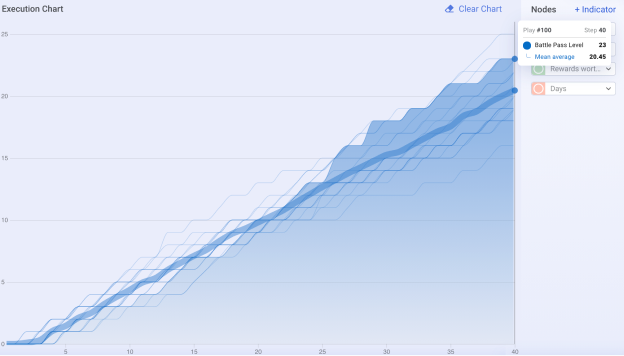
We can see here that our player averages a level of 20 when the battle pass ends (40 days pass) so of course, we are not satisfied with what we have now. There is a multitude of ways in which we can adjust that. For starters we could increase the chances of quests being completed, which translates to making those quests more accessible in-game, we could increase the rewards that each quest gives, we could add extra quests, or make the level requirement lower. For now, let’s pick the option of doubling the rewards, so just set the rewards on each quest to double the amount.
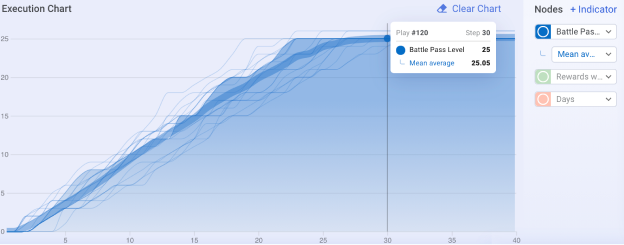
Well, that’s no good either. Our average player now takes 30 days to get to the max level, and the final 10 battle pass days are wasted. Normally that wouldn’t be a problem but for a 40-day battle pass, that’s a quarter of the total time. Depending on each game, battle passes usually have two approaches. Either it’s fairly easy to hit the level cap, provided you are an engaged player, and you can finish some days before the pass ends (not a quarter of the total time though) or it is made so only the most active players can reach the level cap.
But instead of fiddling with the quest rewards, we can also have a look at the level cap. The way rewards are now we are going way over the limit, but if we increase the level cap that won’t be an issue. Let’s try a level cap of 40.
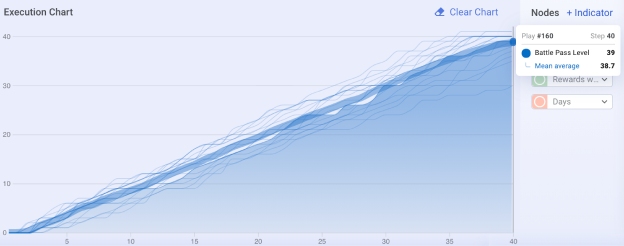
We can see now that our player reaches level 39 on average which is very close to where we actually want it to be. As you can see there are many ways in which we can address the length, quest reward system, or level requirements, they all kind of fall in the same part of the balancing process, which is battle pass length (and quests since we are also talking about the likelihood of them being completed)
It’s time we also look at the rewards. We won’t need to do multiple Quick Plays here as the rewards are constant in our battle pass. I’ve also adjusted the diagram so that players always hit the level cap. We want to see how much value they are getting by playing the game for 40 days.
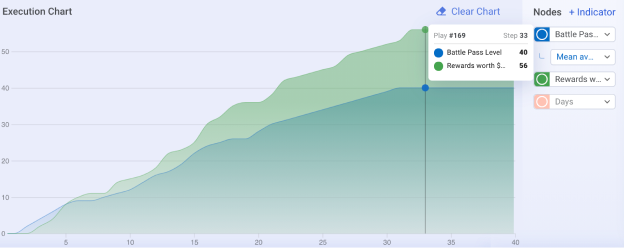
And here it is: 56 dollars worth of items for 40 days. That does seem a bit much and since we’ve increased the level cap but kept the reward system the same, I think it’s time we adjust that as well. Maybe we can give bigger rewards every 10 days rather than every 5 days and make the bigger reward be worth 2 dollars rather than 3.
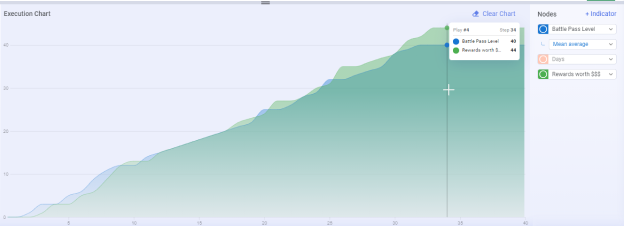
One Quick Run later and here we are, rewards worth 44 dollars are given to the player. If you are satisfied with that we can leave it there, otherwise, adjust it as you will.
We ended up with a battle pass that:
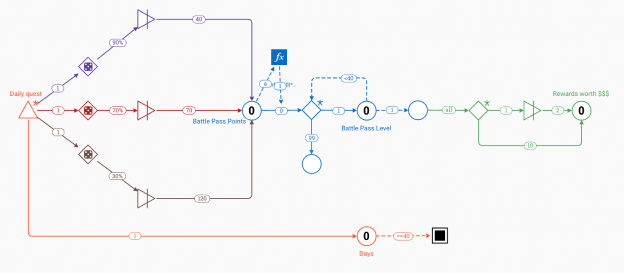
- Has a level cap of 40
- Lasts for 40 days
- Has an increased amount of quest rewards for the player
- Has rewards worth 44 dollars for the player if they fully complete it
It is up to you now to determine what price a battle pass like this should have, or if there is anything that still needs tweaking. It is your model now, after all.
One might think: Ok, but this is just a generic basic pass, scaling that to an actual battle pass with diverse rewards and quests must be insanely hard. Well, not really. You can have a look at some of my models that simulate battle passes from actual games, such as Wild Rift or Genshin Impact.


